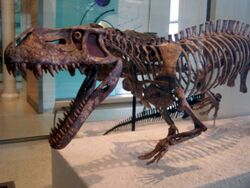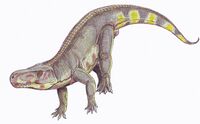Biology:Prestosuchidae
| Prestosuchidae | |
|---|---|

| |
| Mounted skeleton of Prestosuchus at the American Museum of Natural History. | |
| Scientific classification | |
| Missing taxonomy template (fix): | Archosauria/Reptilia |
| Clade: | Pseudosuchia |
| Clade: | Loricata |
| Family: | †Prestosuchidae Romer, 1966 |
| Genera | |
Prestosuchidae (in its widest usage) is a polyphyletic grouping of carnivorous archosaurs that lived during the Triassic. They were large active terrestrial apex predators, ranging from around 2.5 to 7 metres (8.2 to 23.0 ft) in length. They succeeded the Erythrosuchidae as the largest archosaurs of their time. While resembling erythrosuchids in size and some features of the skull and skeleton, they were more advanced in their erect posture and crocodile-like ankle, indicating more efficient gait. "Prestosuchids" flourished throughout the whole of the middle, and the early part of the late Triassic, and fossils are so far known from Europe, India , Africa (Tanzania), Argentina , and Paleorrota in Brazil . However, for a long time experts disagree regarding the phylogenetic relationships of the group, what genera should be included, and whether indeed the "Prestosuchidae" constitute a distinct family.
In 2011, Prestosuchidae in its broadest definition was determined to be a poorly-diagnosed and obsolete polyphyletic group of pseudosuchians (crocodilian-lineage archosaurs) leading to the more "advanced" rauisuchids and crocodylomorphs.[1] Some studies since then have reintroduced the term Prestosuchidae in a more limited setting. In these studies it refers to a clade containing Prestosuchus, Saurosuchus, and Luperosuchus.[2][3] Even so, the validity of this clade is unclear, and it is often not supported over a paraphyletic arrangement of its constituents.[4]
Classification
In 1957, Alan Charig proposed a new family, the Prestosuchidae, to include genera like Mandasuchus, Prestosuchus, and Spondylosoma.[5] In 1967, Alfred Sherwood Romer placed Saurosuchus and Rauisuchus within Erythrosuchidae and adopted the Prestosuchidae to include Prestosuchus, Procerosuchus, and Mandasuchus.
Prestosuchidae have often been included within Rauisuchidae,[6][7][8] although they have sometimes considered the sister group of the aetosaurs in a monophyletic Pseudosuchia,[9] or as a small clade intermediate between basal Crurotarsi and more advanced archosaurs such as the Aetosauridae and Rauisuchidae.[10] J. Michael Parrish's 1993 cladistic analysis of crocodylotarsan archosaurs places the Prestosuchidae (including Prestosuchus, Ticinosuchus, and Saurosuchus) outside the crocodylomorph - poposaurid - rauisuchid - aetosaur clade.[11] In most cladograms, prestosuchids are considered more derived than phytosaurs and ornithosuchids, but usually less derived than the poposaurids and aetosaurs.
A 2011 study of archosaurs by Sterling Nesbitt found that Prestosuchidae is a polyphyletic group of various unrelated suchians. For example, Ticinosuchus was found to be the sister taxon to Paracrocodylomorpha while Prestosuchus and Saurosuchus were basal loricatans. The study determined that many of the characteristics previously used to define Prestosuchidae were present in a wide variety of pseudosuchians. Although Parrish used many traits of the ankle to characterize prestosuchids, Nesbitt showed that these traits were present in various basal suchian groups. In 2004, Benton proposed another trait to define Prestosuchidae: a narrow, triangular antorbital fenestra. However, Nesbitt found this trait in Postosuchus (a rauisuchid), Dromicosuchus (a crocodylomorph), and Fasolasuchus (a basal loricatan).[1]
Evolution of the group
The earliest known "prestosuchid" is Mandasuchus from the Anisian of Tanzania. This was already a large animal, about 4.75 meters long.[12] A similar but smaller form (perhaps the same genus) is Ticinosuchus of the Middle Triassic (Anisian-Ladinian) of Switzerland and Northern Italy, which was about 2.5 meters in length. The huge (6 meters long) Batrachotomus from the latest Middle Triassic (Late Ladinian) of Germany , and Prestosuchus of the early Late Triassic (Carnian) of Brazil may have been closely related animals.[10] Yarasuchus, a lightly built archosaur from the Middle Triassic of India, was once assigned to this group,[13] although a 2017 study placed it as an avemetatarsalian in the newly defined group Aphanosauria.[14] Finally, Saurosuchus was a huge carnivore, 6 or 7 meters long, whose fossils are known from the Late Carnian of Argentina.
List of genera
| Genus | Authors | Year | Status | Age | Location | Unit | Description | Images | |
|---|---|---|---|---|---|---|---|---|---|
| Gower | 1999 | Valid | Late Ladinian | Kupferzell, Crailsheim and Vellberg-Eschenau | 
| ||||
| França Ferigolo Langer |
2011 | Valid | Ladinian | Santa Maria Formation | 
| ||||
| Heptasuchus? | Robert M. Dawley, John M. Zawiskie and J. W. Cosgriff | 1979 | Valid | Carnian | Popo Agie Formation | 
| |||
| Kischlat | 2000 | Junior synonym? | Middle Triassic | Santa Maria Formation | Dubious, probably a synonym of Prestosuchus | ||||
| Romer | 1971 | Valid | Late Ladinian or Early Carnian | Chanares Formation | 
| ||||
| Butler et al. | 2018 | Valid | Anisian | Manda Formation | |||||
| Huene | 1942 | Valid | Late Triassic | Santa Maria Formation | 
| ||||
| Reig | 1959 | Valid | Late Carnian | Ischigualasto Formation | 
| ||||
| Huene | 1938 | Junior synonym? | Anisian | Manda Formation | May be a junior synonym of Prestosuchus | ||||
| Krebs | 1965 | Valid | Late Anisian | Mittlere Grenzbitumenzone | 
|
References
- ↑ 1.0 1.1 Sterling J. Nesbitt (2011). "The Early Evolution of Archosaurs: Relationships and the Origin of Major Clades". Bulletin of the American Museum of Natural History 352: 1–292. doi:10.1206/352.1. https://digitallibrary.amnh.org/handle/2246/6112.
- ↑ Sterling J. Nesbitt; Julia B. Desojo (2017). "The Osteology and Phylogenetic Position of Luperosuchus fractus (Archosauria: Loricata) from the Latest Middle Triassic or Earliest Late Triassic of Argentina". Ameghiniana 54 (3): 261–282. doi:10.5710/AMGH.09.04.2017.3059. https://www.researchgate.net/publication/316028344.
- ↑ Desojo, Julia Brenda; Baczko, María Belén von; Rauhut, Oliver W. M. (2020-02-18). "Anatomy, taxonomy and phylogenetic relationships of Prestosuchus chiniquensis (Archosauria: Pseudosuchia) from the original collection of von Huene, Middle-Late Triassic of southern Brazil" (in en). Palaeontologia Electronica 23 (1): 1–55. doi:10.26879/1026. ISSN 1094-8074. https://palaeo-electronica.org/content/2020/2917-type-materials-of-prestosuchus.
- ↑ Lúcio Roberto-Da-Silva; Rodrigo Temp Müller; Marco Aurélio Gallo de França; Sérgio Furtado Cabreira; Sérgio Dias-Da-Silva (2018). "An impressive skeleton of the giant top predator Prestosuchus chiniquensis (Pseudosuchia: Loricata) from the Triassic of Southern Brazil, with phylogenetic remarks". Historical Biology: An International Journal of Paleobiology 32 (7): 1–20. doi:10.1080/08912963.2018.1559841. https://www.researchgate.net/publication/329894690.
- ↑ Charig, A. J. (1957). "New Triassic archosaurs from Tanganyika, including Mandasuchus and Teleocrater". Dissertation Abstracts, Cambridge University.
- ↑ Gauthier, J. A. (1986). "Saurischian monophyly and the origin of birds". Memoirs of the California Academy of Sciences 8: 1–55.
- ↑ Benton, M. J.; Clark, J. M. (1988). "Archosaur phylogeny and the relationships of the Crocodilia". The Phylogeny and Classification of the Tetrapods. 1. Oxford: Systematics Association. pp. 295–338. ISBN 0-19-857712-5.
- ↑ Benton, M. J.; Walker, A. D. (2002). "Erpetosuchus, a crocodile-like basal archosaur from the Late Triassic of Elgin, Scotland". Zoological Journal of the Linnean Society 136: 25–47. doi:10.1046/j.1096-3642.2002.00024.x.
- ↑ Juul, L. (1994). "The phylogeny of basal archosaurs". Palaeontologia Africana 31: 1–38.
- ↑ 10.0 10.1 Gower, D. J. (2002). "Braincase evolution in suchian archosaurs (Reptilia: Diapsida): evidence from the rauisuchian Batrachotomus kupferzellensis". Zoological Journal of the Linnean Society 136: 49–76. doi:10.1046/j.1096-3642.2002.00025.x.
- ↑ Parrish, J. M. (1993). "Phylogeny of the Crocodylotarsi, with reference to archosaurian and crurotarsan monophyly". Journal of Vertebrate Paleontology 13 (3): 287–308. doi:10.1080/02724634.1993.10011511.
- ↑ Charig, A. J.; Krebs, B.; Sues, H.-D.; Westphal, F. (1976). "Thecodontia". Handbook of Paleoherpetology. Munchen: Verlag Dr. Friedrich Pfeil.
- ↑ Sen, K. (2005). "A new rauisuchian archosaur from the Middle Triassic of India". Palaeontology 48 (1): 185–196. doi:10.1111/j.1475-4983.2004.00438.x.
- ↑ Nesbitt, Sterling J.; Butler, Richard J.; Ezcurra, Martín D.; Barrett, Paul M.; Stocker, Michelle R.; Angielczyk, Kenneth D.; Smith, Roger M. H.; Sidor, Christian A. et al. (27 April 2017). "The earliest bird-line archosaurs and the assembly of the dinosaur body plan" (in En). Nature 544 (7651): 484–487. doi:10.1038/nature22037. ISSN 1476-4687. PMID 28405026. Bibcode: 2017Natur.544..484N. http://pure-oai.bham.ac.uk/ws/files/39495711/Nesbitt_et_al._in_press.pdf.
- Sereno, P. C. 2005. Stem Archosauria—TaxonSearch [version 1.0, 7 November 2005]
External links
Wikidata ☰ Q1060553 entry
 |

